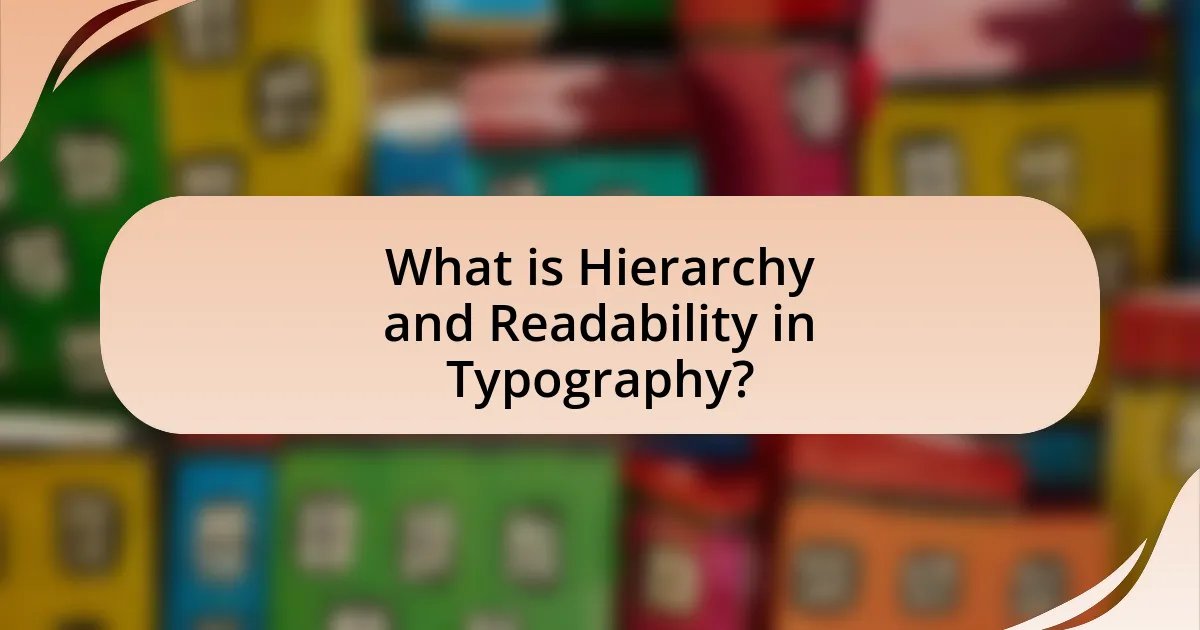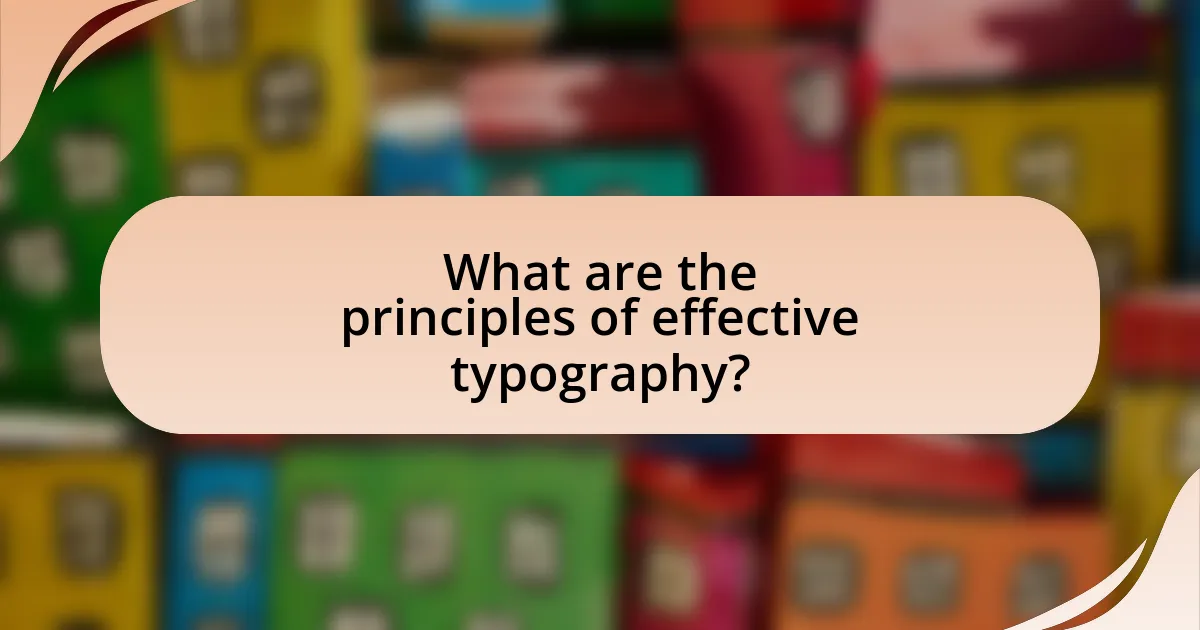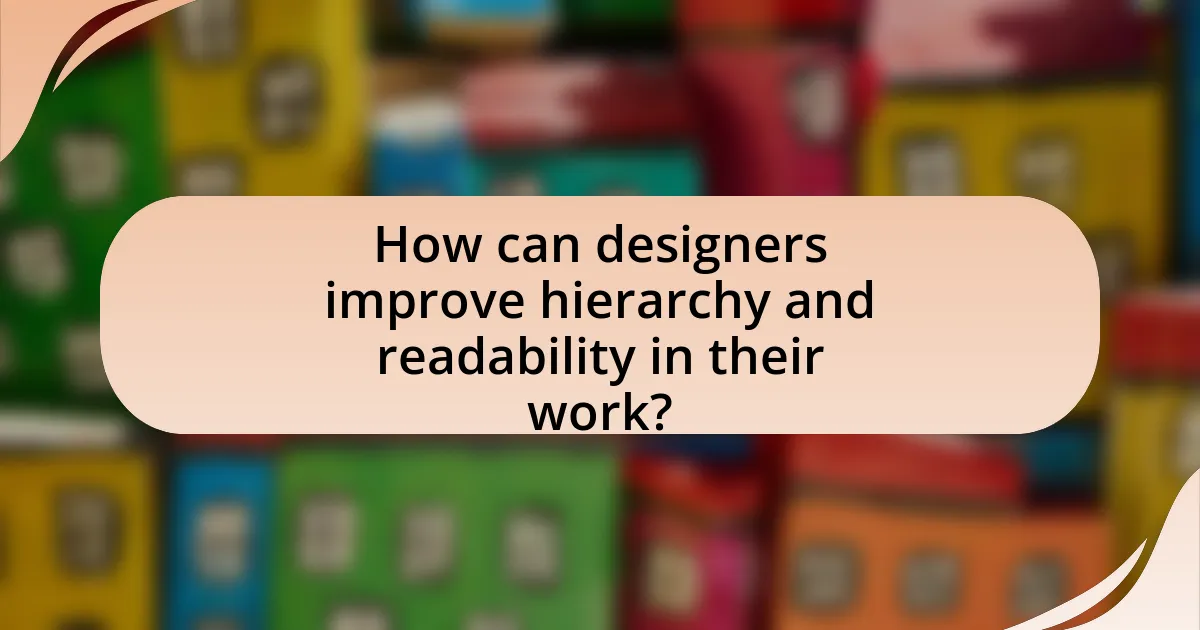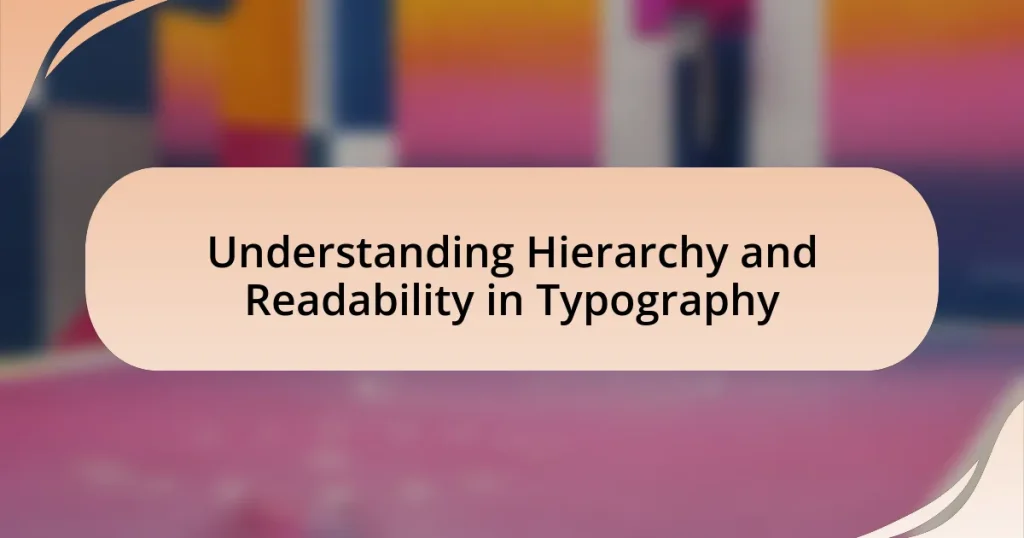Hierarchy and readability are fundamental concepts in typography that significantly influence how text is perceived and understood. Hierarchy involves the strategic arrangement of text elements to indicate their importance, guiding the reader’s attention through the content. Readability refers to the ease with which text can be read and comprehended, affected by factors such as font choice, size, spacing, and contrast. This article explores the relationship between hierarchy and readability, detailing key elements that enhance both, such as size, weight, color, and spacing. It also discusses the impact of effective typography on user experience, engagement, and comprehension, supported by research findings that highlight best practices and common pitfalls in typographic design.

What is Hierarchy and Readability in Typography?
Hierarchy in typography refers to the arrangement of text elements in a way that clearly indicates their importance and guides the reader’s eye through the content. Readability, on the other hand, pertains to how easily text can be read and understood, influenced by factors such as font choice, size, spacing, and contrast. Effective hierarchy enhances readability by using visual cues like size variations, boldness, and color to differentiate headings from body text, thereby improving the overall user experience. Research indicates that well-structured typography can significantly increase comprehension and retention of information, as demonstrated in studies by the International Journal of Human-Computer Studies, which found that typographic hierarchy directly impacts reading speed and understanding.
How do hierarchy and readability influence design choices?
Hierarchy and readability significantly influence design choices by guiding the viewer’s attention and enhancing comprehension. Designers utilize visual hierarchy—through size, color, and placement—to prioritize information, ensuring that the most important elements stand out. For instance, larger fonts typically indicate headings, while smaller fonts are used for body text, creating a clear distinction that aids in navigation. Research shows that effective use of hierarchy can improve user engagement by up to 47%, as it allows users to quickly identify key information (Nielsen Norman Group, 2020). Readability, on the other hand, is affected by font choice, spacing, and contrast, which collectively impact how easily text can be read. Studies indicate that well-chosen typography can increase reading speed by 20% (Tullis & Albert, 2008). Therefore, both hierarchy and readability are essential in making design choices that enhance user experience and communication effectiveness.
What are the key elements of hierarchy in typography?
The key elements of hierarchy in typography include size, weight, color, and spacing. Size differentiates importance, with larger text indicating higher significance, while weight (boldness) emphasizes certain elements over others. Color can create contrast, drawing attention to specific text, and spacing (both line height and letter spacing) affects readability and visual flow. These elements work together to guide the reader’s eye and enhance comprehension, ensuring that the most important information stands out effectively.
How does readability impact user experience?
Readability significantly impacts user experience by influencing how easily users can comprehend and engage with content. High readability ensures that users can quickly grasp information, leading to increased satisfaction and retention. Research indicates that content with optimal readability can improve user engagement metrics; for instance, a study by the Nielsen Norman Group found that users are 124% more likely to engage with content that is easy to read compared to content that is difficult to understand. This demonstrates that enhancing readability not only facilitates better comprehension but also fosters a more positive overall user experience.
Why is hierarchy important in typography?
Hierarchy is important in typography because it organizes content, guiding the reader’s attention and enhancing comprehension. By using varying font sizes, weights, and styles, designers create a visual structure that indicates the importance of information, making it easier for readers to navigate and understand the text. Research shows that effective typographic hierarchy can improve readability by up to 30%, as it helps to distinguish headings, subheadings, and body text, allowing for quicker information processing.
How does hierarchy guide the reader’s attention?
Hierarchy guides the reader’s attention by organizing content in a way that emphasizes the most important information first. This is achieved through visual elements such as size, color, and placement, which create a clear path for the reader’s eye. For instance, larger headings attract attention more effectively than smaller text, making it easier for readers to identify key points quickly. Research shows that readers typically scan text in an F-shaped pattern, where they focus on the top and left side of the content, reinforcing the importance of hierarchical design in directing attention.
What role does visual hierarchy play in content organization?
Visual hierarchy is crucial in content organization as it guides the viewer’s attention and enhances comprehension. By utilizing size, color, contrast, and spacing, visual hierarchy helps prioritize information, making it easier for users to navigate and understand content. Research indicates that effective visual hierarchy can improve user engagement and retention, as users are more likely to absorb information presented in a structured manner. For instance, studies show that well-organized content can increase reading speed by up to 25%, demonstrating the significant impact of visual hierarchy on user experience.

What are the principles of effective typography?
The principles of effective typography include hierarchy, readability, alignment, contrast, and consistency. Hierarchy establishes the importance of information through size, weight, and placement, guiding the reader’s eye. Readability ensures that text is easy to read, influenced by font choice, spacing, and line length. Alignment organizes text in a way that creates a clean layout, while contrast differentiates elements to enhance visibility and focus. Consistency maintains a uniform style throughout a document, reinforcing brand identity and improving user experience. These principles are supported by design theories, such as Gestalt principles, which emphasize how visual elements are perceived as a whole.
How do font choices affect hierarchy and readability?
Font choices significantly influence hierarchy and readability by establishing visual distinctions among text elements. Different fonts can convey varying levels of importance; for instance, bold or larger fonts typically indicate headings or key points, while smaller, lighter fonts are often used for body text. Research indicates that sans-serif fonts enhance readability on screens due to their clean lines, while serif fonts are traditionally preferred for printed materials because they guide the reader’s eye along the lines of text. A study by the University of Reading found that font size and style can affect reading speed and comprehension, demonstrating that appropriate font selection is crucial for effective communication.
What characteristics make a font readable?
A readable font possesses characteristics such as clear letterforms, appropriate spacing, and suitable contrast. Clear letterforms ensure that each character is distinct, reducing confusion between similar letters like ‘b’ and ‘d’. Appropriate spacing, including both letter and line spacing, enhances readability by preventing crowding and allowing the eye to track smoothly across text. Suitable contrast between the font color and background improves visibility, making it easier for readers to discern the text. Research indicates that fonts with these characteristics significantly enhance reading speed and comprehension, as demonstrated in studies by the International Journal of Human-Computer Interaction, which found that increased letter spacing can improve reading performance by up to 20%.
How do different font styles convey different meanings?
Different font styles convey different meanings through their visual characteristics and associations. For instance, serif fonts, such as Times New Roman, often evoke a sense of tradition and reliability, making them suitable for formal documents. In contrast, sans-serif fonts like Arial are perceived as modern and clean, which can enhance readability in digital formats. Script fonts, resembling handwriting, can convey elegance or creativity, often used in invitations or artistic contexts. Research by the American Psychological Association indicates that font choice can significantly influence reader perception and emotional response, demonstrating that typography is not merely aesthetic but also communicative in nature.
What is the relationship between spacing and readability?
Spacing directly influences readability by affecting how easily text can be processed by the reader. Adequate spacing between letters, words, and lines enhances visual clarity, allowing readers to navigate text more efficiently. Research indicates that increased line spacing can improve reading speed and comprehension, as demonstrated in a study by Tinker (1963), which found that optimal line spacing reduces eye strain and facilitates smoother reading flow. Thus, effective spacing is crucial for enhancing the overall readability of text.
How does line spacing affect text legibility?
Line spacing significantly affects text legibility by influencing the readability and comprehension of written content. Adequate line spacing, typically measured in points, helps prevent visual crowding, allowing readers to easily distinguish between lines of text. Research indicates that line spacing of 1.5 to 2 times the font size enhances legibility, as it reduces the likelihood of readers losing their place and improves overall reading speed. A study published in the journal “Information Design Journal” by authors like David Sless supports this, showing that increased line spacing leads to better retention and understanding of information.
What is the impact of letter spacing on readability?
Letter spacing significantly impacts readability by influencing how easily text can be processed by the reader. Research indicates that optimal letter spacing enhances word recognition and reduces visual crowding, which can lead to improved reading speed and comprehension. For instance, a study published in the journal “Vision Research” by researchers at the University of Reading found that increased letter spacing can reduce the likelihood of letters blending together, thereby facilitating clearer reading experiences. This evidence supports the notion that appropriate letter spacing is crucial for effective typography and overall readability.

How can designers improve hierarchy and readability in their work?
Designers can improve hierarchy and readability in their work by utilizing contrast, alignment, and spacing effectively. By applying varying font sizes and weights, designers create a visual distinction between headings, subheadings, and body text, which guides the reader’s eye and emphasizes important information. Research indicates that a 2018 study published in the Journal of Usability Studies found that increased contrast between text and background significantly enhances readability, making it easier for users to process information quickly. Additionally, proper alignment of text elements fosters a clean layout, while adequate spacing between lines and paragraphs prevents clutter, further enhancing readability.
What techniques can enhance typographic hierarchy?
Techniques that can enhance typographic hierarchy include the use of varying font sizes, weights, and styles to create visual distinctions among text elements. For instance, larger font sizes typically indicate headings, while smaller sizes are used for body text, establishing a clear visual order. Additionally, employing different font weights, such as bold for emphasis, helps to differentiate important information from less critical content. The use of contrasting colors can also aid in highlighting key sections, making them stand out. Furthermore, strategic spacing, including line height and letter spacing, contributes to readability and guides the reader’s eye through the text. These techniques collectively improve the organization of information, making it easier for readers to navigate and comprehend the content effectively.
How can color contrast improve readability?
Color contrast significantly improves readability by enhancing the distinction between text and background, making it easier for readers to process information. High contrast, such as black text on a white background, allows for quicker recognition of words and reduces eye strain, which is supported by studies indicating that optimal contrast ratios can increase reading speed and comprehension. For instance, the Web Content Accessibility Guidelines (WCAG) recommend a contrast ratio of at least 4.5:1 for normal text to ensure accessibility and readability for users with visual impairments.
What are the best practices for using size and weight in typography?
The best practices for using size and weight in typography include establishing a clear hierarchy, ensuring readability, and maintaining consistency. A clear hierarchy can be achieved by using larger font sizes for headings and smaller sizes for body text, which helps guide the reader’s eye through the content. Readability is enhanced by selecting appropriate font weights; for instance, using bold weights for emphasis and regular weights for standard text improves legibility. Consistency across a design ensures that similar elements use the same sizes and weights, which fosters a cohesive visual experience. Research indicates that a well-structured typographic hierarchy can increase user engagement by up to 47%, demonstrating the importance of these practices in effective design.
What common mistakes should be avoided in typography?
Common mistakes to avoid in typography include using too many different fonts, neglecting proper spacing, and failing to establish a clear hierarchy. Using multiple fonts can create visual clutter and confuse the reader, while inadequate spacing can lead to poor readability and a cramped appearance. Establishing a clear hierarchy is essential for guiding the reader’s eye and ensuring that important information stands out. Research indicates that effective typography significantly enhances user experience and comprehension, reinforcing the importance of these principles in design.
How can poor hierarchy lead to confusion in content?
Poor hierarchy can lead to confusion in content by obscuring the relationships between ideas and making it difficult for readers to navigate the information presented. When content lacks a clear structure, such as headings, subheadings, and visual cues, readers may struggle to identify the main points and how they connect, resulting in misinterpretation or disengagement. Research indicates that effective visual hierarchy enhances comprehension; for instance, a study published in the journal “Information Design Journal” found that well-structured content significantly improves reader retention and understanding. Thus, poor hierarchy disrupts the flow of information, leading to confusion and reduced clarity.
What are the pitfalls of using too many fonts?
Using too many fonts can lead to decreased readability and a lack of visual coherence in design. When multiple fonts are employed, the viewer may struggle to focus on the content due to competing styles, which can create confusion and distract from the message. Research indicates that designs with excessive font variety can overwhelm users, making it harder for them to process information effectively. For instance, a study published in the journal “Information Design Journal” found that readability significantly declines when more than three different fonts are used in a single layout. This highlights the importance of maintaining a balanced typographic hierarchy to enhance clarity and user engagement.
What practical tips can enhance typography in design projects?
To enhance typography in design projects, use a clear hierarchy by varying font sizes, weights, and styles to guide the reader’s attention. Establishing a visual hierarchy helps prioritize information, making it easier for viewers to navigate content. For instance, using larger, bolder fonts for headings and smaller, lighter fonts for body text creates a structured flow. Additionally, maintaining consistent spacing between lines and paragraphs improves readability, as studies show that optimal line spacing can increase comprehension by up to 20%. Choosing complementary typefaces that align with the project’s tone further enhances visual appeal and coherence.


